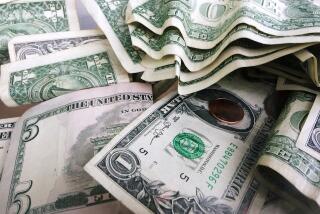What Mattered in Money: The Big 10
- Share via
The dramatic rise of 401(k) retirement plans in the 1990s turned a generation of savers into investors--and just in time for them to enjoy the fruits of the spectacular stock bull market.
Congress never intended for these employer-sponsored tax-deferred plans to be an investment vehicle for the middle class, however. Rather, the chain of events that led to the creation of 401(k)s started with companies’ wanting Congress to approve cash- and profit-sharing plans that would allow workers to shelter bonuses from taxes.
In the 1970s, the Internal Revenue Service began to question whether such plans disproportionately benefited highly paid executives at the expense of lower-paid workers. So a single, innocuous paragraph--to be known as Section 401(k) of the IRS code--was written into the Revenue Act of 1978, allowing for such tax-deferred profit-sharing arrangements so long as they passed a nondiscrimination test.
Two years later, a 38-year-old employee benefits consultant in Philadelphia had an epiphany. Theodore Benna understood that Section 401(k) would only allow executives to defer their profit-sharing bonuses if lower-paid workers also were deriving some benefit from the program.
So while consulting with Cheltenham National Bank on its pension and profit-sharing plan, Benna came up with an idea: Why not have the company set up a retirement savings plan for all workers and match their contributions, much as old-fashioned thrift savings plans did--only it would be tax-deferred.
This would give lower-paid workers an incentive to participate, which in turn would allow highly paid executives to contribute too.
Cheltenham National Bank originally passed on the idea, but Benna eventually implemented it at his own company. Thus, on Jan. 1, 1981, the 401(k) was born.
It nearly died a few years later, however. In 1984, the Reagan administration proposed eliminating 401(k)s, which were costing the government billions of dollars annually in tax revenues, noted David Wray, president of Profit Sharing/401(k) Council of America.
After a grass-roots letter-writing campaign, the White House and Congress eventually backed down. But in 1986, they ended up slashing the maximum annual contribution that plan participants could make from $30,000 to $7,000. (It has since been raised to $10,500.)
Today, about 30 million Americans participate in 401(k) plans, up from 10 million in the mid-1980s.
Because the plans let workers make investment choices themselves--generally either mutual funds or their employer’s stock--401(k)s have allowed Americans to participate in the stock market to an unprecedented degree.
Their contributions have helped stoke the bull market, and the market’s gains have in turn enriched these investors and thus attracted still more 401(k) dollars to the market. The 401(k) “changed the way Americans save and invest,” Wray said. It has also forced many to become more educated about investing in general.
For employers, one of the appeals in promoting the plans is that by making workers more responsible for their own retirement nest eggs, the companies themselves have in many cases de-emphasized their traditional pension plans--so-called defined-benefit plans.
(BEGIN TEXT OF INFOBOX / INFOGRAPHIC)
401(k)s: Where the Money Is
Here is how the typical 401(k) investor has allocated assets within his or her plan, according to an index of plans covering 1.4 million people:
Foreign stocks: 4.2%
Bond/balanced/premixed: 12.8%
U.S. stocks: 36.2%
Company stock: 24.5%
Stable value/money market: 22.4%
Note: Total adds up to more than 100% because of rounding
More to Read
Inside the business of entertainment
The Wide Shot brings you news, analysis and insights on everything from streaming wars to production — and what it all means for the future.
You may occasionally receive promotional content from the Los Angeles Times.










